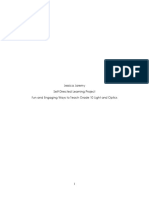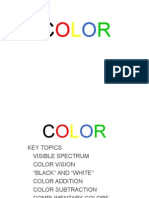Color Light Lab
Color Light Lab
Uploaded by
emily nCopyright:
Available Formats
Color Light Lab
Color Light Lab
Uploaded by
emily nOriginal Description:
Copyright
Available Formats
Share this document
Did you find this document useful?
Is this content inappropriate?
Copyright:
Available Formats
Color Light Lab
Color Light Lab
Uploaded by
emily nCopyright:
Available Formats
Student Name Emily Nivens
Course
Physics
Lab 8- Light and Color
This lab will introduce you to Light and Color, as well as have you explore the nature of
light in relation to color.
For this lab follow the instructions below and answer the questions. Please make sure
that you give as much detail as possible in your final assignment.
Access: Click on Light & Radiation. Launch the Color Vision Simulation.
Part I Use the RGB Bulbs Tab
Each light has a color gradient. For the best results, slide the bar to the very top of each
color. Each color should be observed individually for this first part. To stop the color,
return the bar to the black location. a) What color is seen when the red light is on?Red
b) What color is seen when the green light is on? Green c) What color is seen when
the blue light is on? Blue
For the next part we will investigate the effects of mixing two colors. Before you begin
each part be sure to make a hypothesis.
a) What color do you think the man will see
when red and green are mixed together?Brown
b) Turn on the red and green, both
to the very top of the color scale. What does the man actually see?Yellow
c) Experiment with the degree of color. While doing this, make sure that both
colors are in equal locations on
the scale. What colors are observed? Do
they still fit into the same color family as the color observed in b?
I put the red and blue together, but only halfway up the scale. The man sees a
dark, faded yellow. They fit into the same color family.
Keep the red light on (to the top red location), and turn off the green. We will be looking
at red and blue next. a) What color do you think the man will see when red and blue
are mixed together?Purple b) Turn on the red and blue, both to the very top of the color
scale. What does the man actually see?Pinkish-purple.
c) Experiment with the
degree of color. While doing this, make sure that both colors are in equal locations on
the scale. What colors are observed? Do they still fit into the same color family as the
color observed in b?I put the red and blue together, only halfway up the color scale.
The man sees a darker, more faded version of the same pinkish-purple.
Keep the blue light on (to the top blue location), and turn off the red. We will be looking
at green and blue next.
a) What color do you think the man will see when green
and blue are mixed together?Aqua b) Turn on the green and blue, both to the very top
of the color scale. What does the man actually see?Aqua c) Experiment with the
degree of color. While doing this, make sure that both colors are in equal locations on
the scale. What colors are observed? Do they still fit into the same color family as the
color observed in b?
I put green and blue on halfway up the color scale. The man sees a darker,
more faded version of the aqua.
Now we will be looking at mixing all three colors.
What color do you think the man will see when red, green and blue are all mixed
together? White
Turn on all three colors, all to the very top of the color scale. What does the man actually
see? White
Fill in the color diagram below. Provide the appropriate colors that you observed when
each was mixed. You may use colored pencils if you wish.
RED
BLUEPURPLE
GREEN
RED
Yellow
BLUE
GREENAQUA
Part II Use the Single Bulb Tab
Set the simulation to the following: bulb type white, beam photons, and filter
color off. a) What is coming out of the bulb? b) What color light does the man
see?
Set the simulation to the following: bulb type white, beam solid, and filter color
off.
a) What is coming out of the bulb? b) What color light does the man
see? White
Set the simulation to the following: bulb type white, beam photons, and filter
color on. a) Choose any filter color. Record the color
______Blue______________.
b) What is coming out of the bulb before the filter
(in the area just in front of the filter)? Photons of all different colors.
c) What is
coming out after the filter?Only blue photos
d) What color light does the man
see?Blue
e) Choose another filter color. Record the color
__________Red___________.
f) Repeat questions b-d (above)B. Photons of all
different colors. C. Only red photons. D. Red. Please record your observations as you
answer the questions. g) What is the filter doing?
The filter is making the photons mimic its color.
Set the simulation to the following: bulb type white, beam solid, and filter color
on. a) Choose any filter color. Record the color _________Green___________.
Repeat questions b-d (from question 3
on the last page). Please record your
observations as you answer the questions.B. A white beam of light C. A green beam of
light D. Green
b) Choose another filter color. Record the color
_______Orange_____________. Repeat questions b-d (from question
3 on the
last page). B. A white beam if light C. An orange beam of light D. Orange. Please
record your observations as you answer the questions.
c) What are the differences
between question 3 (photon setting) and question 4 (solid setting)?The photon setting
shows individual photons of different colors that are seen through the eye as white
light. The solid setting shows only the white light.
d) What are the similarities
between question 3 (photon setting) and question 4 (solid setting)? They are both the
same light, the photon setting only shows the photons while the solid setting shows
light as seen to the eye.
Set the simulation to the following: bulb type monochromatic, beam solid, and
filter color on.
a) Select a bulb color and a filter color that are different. Record
the colors chosen below. What does the man
see?
Bulb Color:
__________Yellow___________
Filter Color:
_________Blue____________
Color seen by
the man: Black
b) Select a bulb color and a filter color that are the same. Record
the colors chosen below. What does the man
see?
Bulb Color:
_________Red____________
Filter Color:
________Red_____________
Color seen by
the man: Red
c) What is the filter doing? It does not change the color
because they are the same.
In this activity light was represented in 2 ways as a photon or as a solid. What
explanation can you provide for the nature of light?
The photons come together to make light as the eye sees it, like many small
snowflakes make a snowman.
You might also like
- Color Absorbtion LabDocument3 pagesColor Absorbtion Labdester awake38% (24)
- A Detailed Lesson Plan in Arts IV Manlangit Mapeh 4Document7 pagesA Detailed Lesson Plan in Arts IV Manlangit Mapeh 4Pearl Joy Mijares92% (24)
- Lab 8 - Light and Color (1) PHETDocument6 pagesLab 8 - Light and Color (1) PHETnicwelchNo ratings yet
- 3 Primary ColorsDocument41 pages3 Primary ColorsArnab SenNo ratings yet
- List of Physics MnemonicsDocument13 pagesList of Physics MnemonicsNani60% (5)
- Plate Stresses in STAADDocument7 pagesPlate Stresses in STAADThaung Myint OoNo ratings yet
- (Martin Ferrier Young BSC (Hons Phys) BSC (Chiroprac (B-Ok - CC) PDFDocument271 pages(Martin Ferrier Young BSC (Hons Phys) BSC (Chiroprac (B-Ok - CC) PDFCristian TricaNo ratings yet
- 2 - PhET Simulation - Color VisionDocument3 pages2 - PhET Simulation - Color VisionAva MittoneNo ratings yet
- PhET Simulation - Color VisionDocument3 pagesPhET Simulation - Color VisionDanikaNo ratings yet
- 22-Chapter 27 ColorDocument84 pages22-Chapter 27 ColorsigitNo ratings yet
- Jessica Jaremy Self Directed Learning Light and OpticsDocument39 pagesJessica Jaremy Self Directed Learning Light and Opticsapi-394957459No ratings yet
- Physical Science ActivityDocument2 pagesPhysical Science ActivityJason Tagapan GullaNo ratings yet
- S2-2nd Edit Unit-6 (6.4 Colours of Light)Document18 pagesS2-2nd Edit Unit-6 (6.4 Colours of Light)Kyaw Sit Nyein MaungNo ratings yet
- Lesson 5 (Light Mixing & Dispersion)Document4 pagesLesson 5 (Light Mixing & Dispersion)geraintNo ratings yet
- Mixing and Filtering Color of LightDocument4 pagesMixing and Filtering Color of LightOmar ScafeNo ratings yet
- Detailed Lesson Plan in Arts IVDocument4 pagesDetailed Lesson Plan in Arts IVKyrenz PugradNo ratings yet
- Arts Lesson Plan 3Document6 pagesArts Lesson Plan 3Myla RicamaraNo ratings yet
- Detailed Lesson Plan in ArtsDocument6 pagesDetailed Lesson Plan in ArtsSYED RUHULLAH GANIHNo ratings yet
- Colorvisionphet 2008Document2 pagesColorvisionphet 2008api-278594802No ratings yet
- ArtistsNetwork ColorTheory 2015Document14 pagesArtistsNetwork ColorTheory 2015oviflor100% (2)
- Introduction To Three-Color LightDocument5 pagesIntroduction To Three-Color LightMusa EltayebNo ratings yet
- The Physics of Colour.: 1. How Well Do You See Colour - Are You Colour Blind ?Document2 pagesThe Physics of Colour.: 1. How Well Do You See Colour - Are You Colour Blind ?mdanalisaNo ratings yet
- Dang Nguyen Basic Optic SystemsDocument15 pagesDang Nguyen Basic Optic SystemsNguyễn Hoàng ĐăngNo ratings yet
- Spectra and ColorsDocument9 pagesSpectra and ColorsGaea Cygn BaloNo ratings yet
- FisicaDocument3 pagesFisicaValentina CerdaNo ratings yet
- M&M Color Theory: Red Green BlueDocument5 pagesM&M Color Theory: Red Green BlueHannah KellyNo ratings yet
- Color Theory PDFDocument9 pagesColor Theory PDFFlorin100% (1)
- 4e's LPDocument6 pages4e's LPChenna RoseNo ratings yet
- Color and Dye Structure PDFDocument41 pagesColor and Dye Structure PDFmskhan.bhb100% (1)
- Week-3-Elements and Principles of DesignDocument98 pagesWeek-3-Elements and Principles of Designmjenneth28No ratings yet
- Arts Lesson PlanDocument8 pagesArts Lesson PlanJanine April AmatNo ratings yet
- Lesson 8 Colour GradingDocument17 pagesLesson 8 Colour GradingHansley RambojunNo ratings yet
- Module 3 - Handicraft 7 8 RevisedDocument7 pagesModule 3 - Handicraft 7 8 RevisedBenedick Conrad Glifunia100% (1)
- Inte Science SBA Colour 2Document2 pagesInte Science SBA Colour 2Lerek RichardsonNo ratings yet
- Chapter 4Document14 pagesChapter 4dawit TerefeNo ratings yet
- In Reality, There Are No Primary ColorsDocument29 pagesIn Reality, There Are No Primary ColorsFrancescoEmilioNeriNo ratings yet
- ColorAbsorptionSEDocument6 pagesColorAbsorptionSEJayden CalvinNo ratings yet
- Color Vision PHETDocument2 pagesColor Vision PHETZaid SyedNo ratings yet
- 7 - LightDocument51 pages7 - LightrctesorioNo ratings yet
- Activity-sheet_-Light-and-FiltersDocument7 pagesActivity-sheet_-Light-and-FiltersprinsayuanumbayNo ratings yet
- 2art First Grading Educ Lesson 2 - Value and ColorDocument102 pages2art First Grading Educ Lesson 2 - Value and Colorapi-288938459100% (1)
- 8je4 Colour QuestionsDocument1 page8je4 Colour Questionsiama.winner2023No ratings yet
- Chapter 3 Color - TheoryDocument41 pagesChapter 3 Color - TheoryRafifa IslamNo ratings yet
- Conductingasurvey 240103163701 007007f0Document77 pagesConductingasurvey 240103163701 007007f0piaangNo ratings yet
- Colors of LightDocument16 pagesColors of Lightmelanieserman1110No ratings yet
- Intro To Color Theory PDFDocument6 pagesIntro To Color Theory PDFGauri ChincholkarNo ratings yet
- Color TheoryDocument29 pagesColor TheoryAnshul RaskarNo ratings yet
- Q3 Mapeh 6 Week 2Document75 pagesQ3 Mapeh 6 Week 2Raul TubilNo ratings yet
- Lab Report ColorsDocument2 pagesLab Report Colorsapi-297945827No ratings yet
- Module 5 Colors of LightDocument25 pagesModule 5 Colors of LightRochelle Mae G. IrincoNo ratings yet
- SPA Visual Arts Grade 8 Quarter 1 Module 5Document8 pagesSPA Visual Arts Grade 8 Quarter 1 Module 5Carmelle Denise GarciaNo ratings yet
- Light 4Document2 pagesLight 4adsp11No ratings yet
- Primary ColorsDocument10 pagesPrimary ColorsSherilyn ApostolNo ratings yet
- Colour Theory and Colour Emotions For Design ExamsDocument70 pagesColour Theory and Colour Emotions For Design ExamssljpriyadarshiniNo ratings yet
- Color Vision FinalDocument47 pagesColor Vision FinalRebecca Castillo KalawNo ratings yet
- 2023MAPEH3Q1Document10 pages2023MAPEH3Q1Shee SheNo ratings yet
- Color Temperature and Color Correction FotoDocument10 pagesColor Temperature and Color Correction FotoAida ȚurleaNo ratings yet
- Attachment 2Document27 pagesAttachment 2Tracy MakunguNo ratings yet
- How To Use The Color WheelDocument8 pagesHow To Use The Color WheelAv AlexandraNo ratings yet
- Ba 0453 Perfect ColorDocument26 pagesBa 0453 Perfect Colordiana_nevskayaNo ratings yet
- Chapter 21 - ColoursDocument7 pagesChapter 21 - ColoursWei XiuNo ratings yet
- Color Theory PDFDocument5 pagesColor Theory PDFMartin GriffinNo ratings yet
- Trogonometric Equation Theory - HDocument10 pagesTrogonometric Equation Theory - HthinkiitNo ratings yet
- How To Size Differential Pressure Regulator For Seal Oil System - ( - BEST - )Document6 pagesHow To Size Differential Pressure Regulator For Seal Oil System - ( - BEST - )Muhammad ImranNo ratings yet
- Prediction of Engineering Properties of Fine-Grained Soils From Their Index PropertiesDocument12 pagesPrediction of Engineering Properties of Fine-Grained Soils From Their Index PropertiesFaran AsifNo ratings yet
- Fluent12 Workshop05 CentrifugalDocument29 pagesFluent12 Workshop05 CentrifugalAboMuhmadSr.No ratings yet
- MATH 141 Webworks .Set1Document2 pagesMATH 141 Webworks .Set1razanmk961214No ratings yet
- Pulley MA SystemsDocument14 pagesPulley MA SystemsgameraviNo ratings yet
- ECE5710 Notes02Document33 pagesECE5710 Notes02FREDERICKNo ratings yet
- Signals and Systems Question BankDocument3 pagesSignals and Systems Question BankEdward HarveyNo ratings yet
- Bacteriological Analytical Manual (BAM) - BAM - Aerobic Plate CountDocument6 pagesBacteriological Analytical Manual (BAM) - BAM - Aerobic Plate Countg44104016No ratings yet
- Laplace Transforms - GATE Study Material in PDFDocument7 pagesLaplace Transforms - GATE Study Material in PDFsreeNo ratings yet
- Deep ScreeningDocument41 pagesDeep ScreeningSuciu FlorinNo ratings yet
- Pressure Vessel Handbook Ninth Edition 1992 PDFDocument481 pagesPressure Vessel Handbook Ninth Edition 1992 PDFjudico60_70175733No ratings yet
- Thermodynamics (Mapua U)Document12 pagesThermodynamics (Mapua U)Basil Bautista0% (1)
- Analysis of Steering Knuckle of All Terrain Vehicl PDFDocument10 pagesAnalysis of Steering Knuckle of All Terrain Vehicl PDFpranavNo ratings yet
- Turbine Stress Evaluator (Tse) Turbine Stress Evaluator)Document3 pagesTurbine Stress Evaluator (Tse) Turbine Stress Evaluator)Prakash ChoudharyNo ratings yet
- Lecture 12 - FAULT TREE ANALYSIS (FTA) - ConstructionDocument25 pagesLecture 12 - FAULT TREE ANALYSIS (FTA) - ConstructionBalamurugan ThirunavukkarasuNo ratings yet
- Modern Physics PDFDocument30 pagesModern Physics PDFaayush tomarNo ratings yet
- Laboratory 2 - Geological MappingDocument9 pagesLaboratory 2 - Geological Mappingepyt louiseNo ratings yet
- Question Chapter 2 - 002Document22 pagesQuestion Chapter 2 - 002Smk Dato Shahbandar HussainNo ratings yet
- Physics Special Focus ElectrostaticsDocument78 pagesPhysics Special Focus ElectrostaticsPeter Lee100% (1)
- SHM 005 Clip Visibility1Document14 pagesSHM 005 Clip Visibility1Dipanjan ChoudhuryNo ratings yet
- Re La To RioDocument5 pagesRe La To RioLuan MedeirosNo ratings yet
- Dissolution Calibration NetDocument7 pagesDissolution Calibration Net0921pyNo ratings yet
- RR 105Document130 pagesRR 105Dr R Panneer SelvamNo ratings yet
- Unit Operations of Chemical Engineering McCabe 11-3Document2 pagesUnit Operations of Chemical Engineering McCabe 11-3rajkranga0% (2)
- Class 4 Tapered MemberDocument8 pagesClass 4 Tapered MemberGicuNo ratings yet
- Sepl Esr GSRDocument4 pagesSepl Esr GSRSyed Mohd MehdiNo ratings yet

























































































